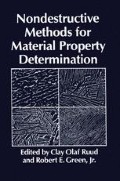Summary
For any heat-treatable aluminum alloy reporting strength or hardness (H) with electrical conductivity (C), the accumulations of data fall into regressing scatterbands which trend down in H and up in C. Conductivity is useful for sensing anomalies in products made with these alloys, but the relationship is too dispersed to find usefully accurate hardness or strength values. The vagueness is commonly attributed to conductivity measurement inaccuracies.
For a program studying C vs H relationships in the 2219 alloy, specimens were produced with a variety of thermal histories: that is, combinations of quenching time and aging time. Each specimen was found to have a unique C vs H coordinate position. Plotted on a C vs H format, these points fill a fan-like envelope. The envelope can be divided into progressive stages of quenching time (Qt) and into progressive stages of aging time (At). In principle, a point defined by values of H and C will reveal the values for Qt and At. Either pair of these dimensions will identify the metallurgical status.
With slower quench rates H decreases and C increases to mark an HC locus which does lie parallel to the familiar axis of regression. Moving down this locus marks degradation by the increase of the coarse 8 precipitate (which forms at higher temperatures). In contrast, aging a quenched specimen at lower temperatures causes an HC locus which traces a path across this regression axis to give breadth to the envelope. This records the precipitation of the fine θ′ and θ″ strengthing precipitates.
The envelope of practical possibilities makes it clear that any collection of pieces with the same nominal strengths actually can have a wide range of conductivities. With the results of an organized thermal history variety, it is possible to demonstrate the metallurgical differences that account for this.
This work creates a model that coherently and quantitatively ties two nondestructively acquired properties to thermal history and metallurgical condition. This model demonstrates that strength cannot be specified from conductivity alone. However, it shows that the combination of conductivity and hardness can be used to solve for the particular metallurgical condition of an alloy piece. From this known condition we should be able to know all the properties associated with it.
Access this chapter
Tax calculation will be finalised at checkout
Purchases are for personal use only
Preview
Unable to display preview. Download preview PDF.
References
E. Hornbogen, Aluminum, Volume 43, 1967, Parts I–IV.
R.A. Chihoski, Metal Progress, Conductivity-Hardness Reveal Heat Treat History of Aluminum Alloys, Part I, May 1983, pp. 27–32.
R.A. Chihoski, Metal Progress, Part II, July 1983, pp. 27–34.
Author information
Authors and Affiliations
Editor information
Editors and Affiliations
Rights and permissions
Copyright information
© 1984 Plenum Press, New York
About this chapter
Cite this chapter
Chihoski, R.A. (1984). Solving for Thermal History and Metallurgical Condition of a Quenched and Aged Aluminum Alloy through Conductivity and Hardness Properties. In: Ruud, C.O., Green, R.E. (eds) Nondestructive Methods for Material Property Determination. Springer, Boston, MA. https://doi.org/10.1007/978-1-4684-4769-9_7
Download citation
DOI: https://doi.org/10.1007/978-1-4684-4769-9_7
Publisher Name: Springer, Boston, MA
Print ISBN: 978-1-4684-4771-2
Online ISBN: 978-1-4684-4769-9
eBook Packages: Springer Book Archive

